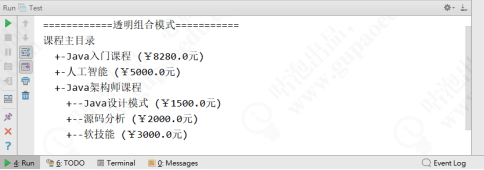没有性能瓶颈的无限级菜单树应该这样设计
本文节选自《设计模式就该这样学》
1 使用透明组合模式实现课程目录结构#
以一门网络课程为例,我们设计一个课程的关系结构。比如,我们有Java入门课程、人工智能课程、Java设计模式、源码分析、软技能等,而Java设计模式、源码分析、软技能又属于Java架构师系列课程包,每个课程的定价都不一样。但是,这些课程不论怎么组合,都有一些共性,而且是整体和部分的关系,可以用组合模式来设计。首先创建一个顶层的抽象组件CourseComponent类。
/**
* Created by Tom.
*/
public abstract class CourseComponent {
public void addChild(CourseComponent catalogComponent){
throw new UnsupportedOperationException("不支持添加操作");
}
public void removeChild(CourseComponent catalogComponent){
throw new UnsupportedOperationException("不支持删除操作");
}
public String getName(CourseComponent catalogComponent){
throw new UnsupportedOperationException("不支持获取名称操作");
}
public double getPrice(CourseComponent catalogComponent){
throw new UnsupportedOperationException("不支持获取价格操作");
}
public void print(){
throw new UnsupportedOperationException("不支持打印操作");
}
}
把所有可能用到的方法都定义到这个顶层的抽象组件中,但是不写任何逻辑处理的代码,而是直接抛异常。这里,有些小伙伴会有疑惑,为什么不用抽象方法?因为用了抽象方法,其子类就必须实现,这样便体现不出各子类的细微差异。所以子类继承此抽象类后,只需要重写有差异的方法覆盖父类的方法即可。
然后分别创建课程Course类和课程包CoursePackage类。创建Course类的代码如下。
/**
* Created by Tom.
*/
public class Course extends CourseComponent {
private String name;
private double price;
public Course(String name, double price) {
this.name = name;
this.price = price;
}
@Override
public String getName(CourseComponent catalogComponent) {
return this.name;
}
@Override
public double getPrice(CourseComponent catalogComponent) {
return this.price;
}
@Override
public void print() {
System.out.println(name + " (¥" + price + "元)");
}
}
创建CoursePackage类的代码如下。
/**
* Created by Tom.
*/
public class CoursePackage extends CourseComponent {
private List<CourseComponent> items = new ArrayList<CourseComponent>();
private String name;
private Integer level;
public CoursePackage(String name, Integer level) {
this.name = name;
this.level = level;
}
@Override
public void addChild(CourseComponent catalogComponent) {
items.add(catalogComponent);
}
@Override
public String getName(CourseComponent catalogComponent) {
return this.name;
}
@Override
public void removeChild(CourseComponent catalogComponent) {
items.remove(catalogComponent);
}
@Override
public void print() {
System.out.println(this.name);
for(CourseComponent catalogComponent : items){
//控制显示格式
if(this.level != null){
for(int i = 0; i < this.level; i ++){
//打印空格控制格式
System.out.print(" ");
}
for(int i = 0; i < this.level; i ++){
//每一行开始打印一个+号
if(i == 0){ System.out.print("+"); }
System.out.print("-");
}
}
//打印标题
catalogComponent.print();
}
}
}
最后编写客户端测试代码。
public static void main(String[] args) {
System.out.println("============透明组合模式===========");
CourseComponent javaBase = new Course("Java入门课程",8280);
CourseComponent ai = new Course("人工智能",5000);
CourseComponent packageCourse = new CoursePackage("Java架构师课程",2);
CourseComponent design = new Course("Java设计模式",1500);
CourseComponent source = new Course("源码分析",2000);
CourseComponent softSkill = new Course("软技能",3000);
packageCourse.addChild(design);
packageCourse.addChild(source);
packageCourse.addChild(softSkill);
CourseComponent catalog = new CoursePackage("课程主目录",1);
catalog.addChild(javaBase);
catalog.addChild(ai);
catalog.addChild(packageCourse);
catalog.print();
}
运行结果如下图所示。
透明组合模式把所有公共方法都定义在 Component 中,这样客户端就不需要区分操作对象是叶子节点还是树枝节点;但是,叶子节点会继承一些它不需要(管理子类操作的方法)的方法,这与设计模式的接口隔离原则相违背。
2 使用安全组合模式实现无限级文件系统#
再举一个程序员更熟悉的例子。对于程序员来说,电脑是每天都要接触的。电脑的文件系统其实就是一个典型的树形结构,目录包含文件夹和文件,文件夹里面又可以包含文件夹和文件。下面用代码来实现一个目录系统。
文件系统有两个大的层次:文件夹和文件。其中,文件夹能容纳其他层次,为树枝节点;文件是最小单位,为叶子节点。由于目录系统层次较少,且树枝节点(文件夹)结构相对稳定,而文件其实可以有很多类型,所以我们选择使用安全组合模式来实现目录系统,可以避免为叶子节点类型(文件)引入冗余方法。首先创建顶层的抽象组件Directory类。
public abstract class Directory {
protected String name;
public Directory(String name) {
this.name = name;
}
public abstract void show();
}
然后分别创建File类和Folder类。创建File类的代码如下。
public class File extends Directory {
public File(String name) {
super(name);
}
@Override
public void show() {
System.out.println(this.name);
}
}
创建Folder类的代码如下。
import java.util.ArrayList;
import java.util.List;
public class Folder extends Directory {
private List<Directory> dirs;
private Integer level;
public Folder(String name,Integer level) {
super(name);
this.level = level;
this.dirs = new ArrayList<Directory>();
}
@Override
public void show() {
System.out.println(this.name);
for (Directory dir : this.dirs) {
//控制显示格式
if(this.level != null){
for(int i = 0; i < this.level; i ++){
//打印空格控制格式
System.out.print(" ");
}
for(int i = 0; i < this.level; i ++){
//每一行开始打印一个+号
if(i == 0){ System.out.print("+"); }
System.out.print("-");
}
}
//打印名称
dir.show();
}
}
public boolean add(Directory dir) {
return this.dirs.add(dir);
}
public boolean remove(Directory dir) {
return this.dirs.remove(dir);
}
public Directory get(int index) {
return this.dirs.get(index);
}
public void list(){
for (Directory dir : this.dirs) {
System.out.println(dir.name);
}
}
}
注意,Folder类不仅覆盖了顶层的show()方法,还增加了list()方法。
最后编写客户端测试代码。
public static void main(String[] args) {
System.out.println("============安全组合模式===========");
File qq = new File("QQ.exe");
File wx = new File("微信.exe");
Folder office = new Folder("办公软件",2);
File word = new File("Word.exe");
File ppt = new File("PowerPoint.exe");
File excel = new File("Excel.exe");
office.add(word);
office.add(ppt);
office.add(excel);
Folder wps = new Folder("金山软件",3);
wps.add(new File("WPS.exe"));
office.add(wps);
Folder root = new Folder("根目录",1);
root.add(qq);
root.add(wx);
root.add(office);
System.out.println("----------show()方法效果-----------");
root.show();
System.out.println("----------list()方法效果-----------");
root.list();
}
运行结果如下图所示。
安全组合模式的好处是接口定义职责清晰,符合设计模式的单一职责原则和接口隔离原则;缺点是客户需要区分树枝节点和叶子节点,这样才能正确处理各个层次的操作,客户端无法依赖抽象接口(Component),违背了设计模式的依赖倒置原则。
关注微信公众号『 Tom弹架构 』回复“设计模式”可获取完整源码。
本文为“Tom弹架构”原创,转载请注明出处。技术在于分享,我分享我快乐!
如果本文对您有帮助,欢迎关注和点赞;如果您有任何建议也可留言评论或私信,您的支持是我坚持创作的动力。关注微信公众号『 Tom弹架构 』可获取更多技术干货!






【推荐】国内首个AI IDE,深度理解中文开发场景,立即下载体验Trae
【推荐】编程新体验,更懂你的AI,立即体验豆包MarsCode编程助手
【推荐】抖音旗下AI助手豆包,你的智能百科全书,全免费不限次数
【推荐】轻量又高性能的 SSH 工具 IShell:AI 加持,快人一步
· 开发者必知的日志记录最佳实践
· SQL Server 2025 AI相关能力初探
· Linux系列:如何用 C#调用 C方法造成内存泄露
· AI与.NET技术实操系列(二):开始使用ML.NET
· 记一次.NET内存居高不下排查解决与启示
· Manus重磅发布:全球首款通用AI代理技术深度解析与实战指南
· 被坑几百块钱后,我竟然真的恢复了删除的微信聊天记录!
· 没有Manus邀请码?试试免邀请码的MGX或者开源的OpenManus吧
· 园子的第一款AI主题卫衣上架——"HELLO! HOW CAN I ASSIST YOU TODAY
· 【自荐】一款简洁、开源的在线白板工具 Drawnix